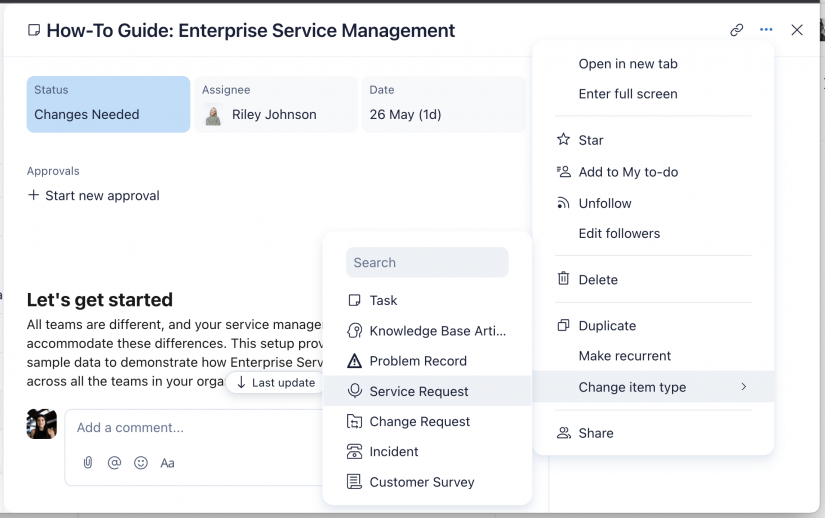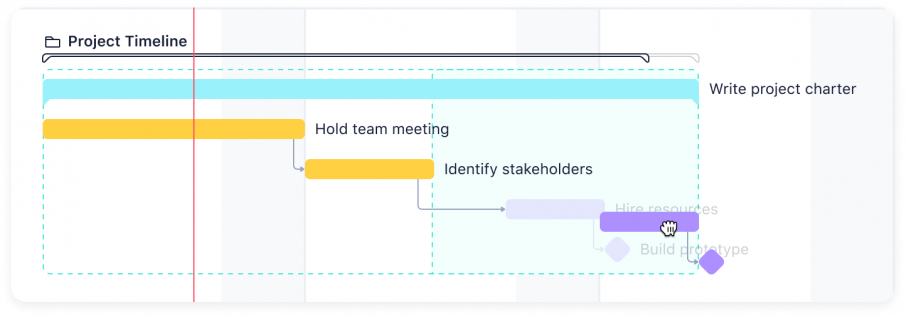Key takeaways:
- What makes Wrike a strong choice? Wrike offers advanced customization, extensive integrations, and superior reporting features tailored for various teams and project types.
- How does Zoho Projects support team collaboration? Zoho Projects provides essential collaboration tools like comments, tagging, and multiple work views, including Gantt and Kanban.
- What is the pricing difference between Wrike and Zoho Projects? Wrike’s plans start at $10 per user, while Zoho offers a budget-friendly option starting at $3 per user.
- Which platform is better for creative teams? Wrike outperforms Zoho Projects in creative management due to its native proofing functionality and integrations with tools like Adobe Creative Cloud.
- Why choose Wrike over Zoho Projects? Wrike is ideal for larger teams needing customization and resource allocation, making it a top project management solution.
There are many work management platforms on the market. And it can be difficult to vet each one and determine which one is the best fit for your team. Many project managers are choosing between popular tools like Wrike, Monday.com, Jira, and Zoho Projects. Initially, the features within each of these tools may look similar to each other. But there are some significant differentiators that make each platform unique.
Let’s compare Wrike vs. Zoho Projects, so you can understand why Wrike outperforms the competition. Or start a free two-week trial of Wrike to jump straight in and see for yourself!
What is Wrike?
Wrike is a fully-featured project management software with functionalities ranging from resource allocation to budgeting and collaborative project management. It’s ideal for teams and organizations that are serious about optimizing and streamlining operations and processes and improving team productivity and engagement. The software makes it easy to customize your workspace to reflect your branding and tackle your needs. Rather than changing your processes to fit the software, you customize Wrike to fit your business.
Explore Wrike for yourself by starting a free two-week trial.
What is Zoho Projects?
Zoho Projects is the project management tool from the renowned software company Zoho. This software has numerous features for managing projects like project planning, time tracking, reporting, calendars, reminders, and communications. Zoho Projects has a free plan and mid-range prices for paid plans. This software is used by businesses of every size, worldwide.
What are the key features of Wrike?
Key features are an essential factor when choosing a project management tool. Let’s take a quick look at the key features of Wrike.
1. Infinite item hierarchy
Wrike users can create as many levels of spaces, projects, folders, tasks, and subtasks as needed to break down complex projects into manageable pieces. The hierarchy is flexible and can be customized to suit the needs of each space, department, or project. This feature helps teams stay organized and ensures that everyone has a clear understanding of their tasks and responsibilities.
2. Custom item types
Within Wrike, users can create custom item types, custom fields, and custom workflows to match their unique project management needs. For example, a marketing team might create a custom item type for new campaign ideas, while a software development team might create a custom item type for tracking bugs and issues. This feature allows teams to tailor Wrike to their specific needs and workflows, improving their efficiency and productivity.

3. Native proofing functionality
Wrike Proof allows users to review and approve files directly within the platform. This feature streamlines the review process and eliminates the need for external proofing tools or email chains. Users can annotate files, leave comments, and approve changes, all within the Wrike interface. This feature saves time and reduces the risk of errors or miscommunications.
What are the key features of Zoho Projects?
Now that we’ve discussed the key features of Wrike, let’s dive into the key features of Zoho Projects to better understand its capabilities.
1. Gantt charts
Gantt charts are a visual representation of a project timeline that displays tasks, dependencies, and milestones in a single view. This feature allows teams to track project progress, identify potential delays, and adjust timelines as needed. The Gantt chart in Zoho Projects is interactive and customizable, making it easy to update and share with team members and stakeholders.

2. Issue management
This feature allows teams to track and manage bugs, defects, and other issues that arise during the project lifecycle. Users can create custom workflows for issue resolution, assign tasks to team members, and track the status of each issue. Zoho Projects also offers built-in communication tools, such as commenting and tagging, that make it easy to collaborate and resolve issues quickly.
3. Time tracking
Zoho’s time tracking feature makes use of a timesheet. Each user’s hours worked are logged in the timesheet. Users can opt to use the timers or choose to manually log in the hours worked. If you choose to use the timer, the time spent working is automatically added to the timesheet once the task is complete. Otherwise, you can manually add any time spent in your project timesheets. Timesheets in Zoho can be turned into invoices to send directly to your clients.
Pricing comparison between Wrike and Zoho Projects
In terms of pricing, Wrike and Zoho Projects offer similar options but with some differences. Wrike has four pricing plans, starting from a free option with basic functionalities and going up to an enterprise-level plan that can be customized according to specific needs. Prices vary depending on the number of users and features required. On the other hand, Zoho Projects also offers a free option and three paid plans, with prices determined by the number of projects and users. However, Zoho Projects offers more affordable paid plans than Wrike, with the cheapest plan starting at $3 per user per month, whereas Wrike’s cheapest paid plan starts at $10 per user per month. Therefore, Zoho Projects may be a more budget-friendly option for teams, especially those with a lower budget or smaller size. However, Zoho users would be missing out on advanced functionality that may make Wrike worth paying for in the long run.
Advantages of using Wrike
Wrike is a powerful project management tool that offers numerous benefits to businesses of all sizes. Its advanced features and functionalities make it an ideal platform for optimizing and streamlining operations, increasing team productivity, and improving collaboration. Here are some of the top benefits of using Wrike:
Customizable and versatile
One of the main advantages of using Wrike is its high level of customization and versatility. Wrike is significantly more customizable than the competition. With customizable fields, workflows, and dashboards, users can tailor Wrike to their specific needs and workflows, making it a truly flexible platform. Wrike also allows for customization of request forms, work schedules, project templates, and reporting tools.
400+ integrations
With over 400 integrations available, including popular tools like Slack, Gmail, and Microsoft Teams, Wrike can seamlessly integrate with existing workflows and tools. This not only saves time but also improves collaboration and communication across teams and departments. Additionally, Wrike offers a powerful API that allows for deeper integrations and customization.
Use cases for every department
Wrike can be used by every department within an organization, from marketing to operations to product development. This is because Wrike offers a range of tools and features that can be customized to fit the unique needs of each department. For example, marketing teams can use Wrike to track campaign performance, manage content calendars, and collaborate with agencies and vendors, while operations teams can use Wrike to manage inventory, track orders, and streamline logistics.
Advantages of using Zoho Projects
While Zoho Projects may not be the right fit for every team, its features can streamline processes and improve productivity. Here are some of the top benefits of using Zoho Projects:
Team collaboration
Zoho Projects offers a range of collaboration and communication tools, making it easy for teams to work together and stay connected. Users can leave comments, tag team members, and share files within the platform, improving communication and ensuring that everyone has access to the information they need.
That being said, nearly every project management tool on the market offers the same type of collaborative features. So while this is a benefit of using Zoho Projects, it’s not a unique advantage.
Multiple work views
Zoho Projects offers multiple views that provide teams with different perspectives on their projects and tasks. The platform offers Kanban, Gantt chart, Calendar, List, and Dashboard views to its users. With these multiple views, Zoho Projects allows teams to choose the view that works best for them and their project management needs, improving their ability to stay organized and on track.
However, many other project management solutions can also make this claim. In today’s modern workplace, every team and every professional wants to view their work in multiple ways. So this is offered by many of Zoho Project’s competitors and doesn’t necessarily set the system apart from the rest.
Who should you choose: Zoho vs. Wrike
Now that we’ve discussed the key features and benefits of Zoho Projects vs. Wrike, it’s time to compare the two and see which platform is best suited for your team.
- Reporting: While both Wrike and Zoho Projects offer reporting capabilities, Wrike reports offer more advanced and customizable options. Wrike reports provide a more comprehensive overview of project progress, allowing teams to track critical project metrics in real time. Additionally, Wrike’s reports are highly interactive and allow for easy drill down, enabling teams to identify and address issues quickly. In comparison, Zoho Projects’ reporting options are more limited, with fewer customization options and visualization choices — making it difficult to identify key metrics and resolve risks in a timely manner.
- Creative Processes: When it comes to project management for creative teams, Wrike offers several advantages over Zoho Projects. Wrike’s native proofing functionality streamlines the review and approval process of creative content, ensuring that teams can deliver high-quality work on time. Additionally, Wrike’s 400+ integrations with popular creative tools like Adobe Creative Cloud, make it easy for creative teams to collaborate seamlessly and work with the tools they’re already familiar with. While Zoho Projects offers some creative project management features, Wrike’s robust and tailored functionalities make it the better option for creative teams.
- Collaboration: Both Wrike and Zoho Projects offer collaboration features, but Wrike’s collaboration functionalities are more advanced and user-friendly. While Zoho Projects offers some collaboration features, Wrike’s are more intuitive and the better option for teams looking to optimize collaboration and communication.
- Pricing: Wrike offers more pricing options, with plans starting at $10 per user per month. Zoho offers a free plan, but Wrike’s comparable plans offer much more for the user.
Based on these factors, Wrike is the better option for larger teams that require extensive customization and integration options. On the other hand, Zoho Projects may be better suited for smaller teams looking for an issue-tracking platform. But if you’re looking for a better, similar app to Zoho Projects, Wrike is the best Zoho Projects alternative on the market.
Streamline your workflows with Wrike
After comparing the key features and benefits of both Wrike and Zoho Projects, it’s clear that Wrike is the best project management software option for most teams. Wrike offers more extensive customization and integration options, making it ideal for larger teams with complex workflows. Wrike’s customizable templates and powerful reporting features make it easy to adapt to your specific needs and achieve your project goals.
Plus, Wrike’s intuitive interface, resource allocation, task management, and time-tracking features make it an all-in-one solution for your team’s project management needs.
If you’re looking for a versatile project management platform that can be customized to your specific needs, Wrike is the clear choice. With Wrike, you can optimize and streamline your workflows and operations, improve team productivity, and achieve your project goals efficiently. Try Wrike today, and see how it can enhance your team’s project management experience.



